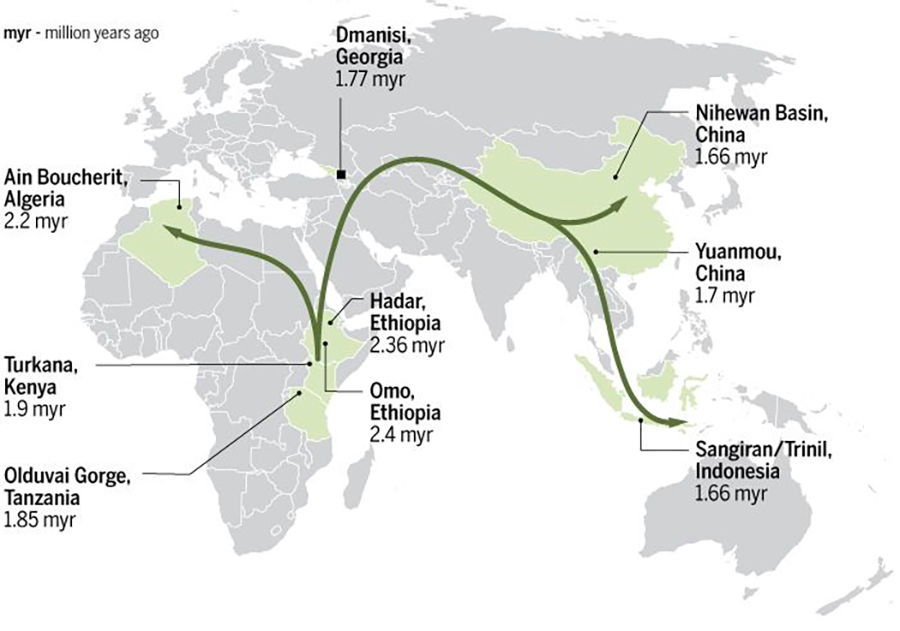- The species Homo erectus was present in Eurasia, possibly as early as 2.0 million years ago
- Environmental change in North Africa would have allowed movement through the Sahara region
- Hominins leaving Africa would have needed to adapt to new climates in order to successfully expand into Eurasia
Highlights
Between cars, airplanes, boats, and trains, it’s pretty easy today to move people and things around the world. And when we do travel, we can easily find restaurants to feed us, hotels to house us, and maps to guide us along the way. But what did we do before all these things? And why would our hominin ancestors leave their familiar homes for the unknown?
Seeking new resources
Migration refers to movement of people or animals from one place to another. Today we often see this occur seasonally as animals follow resources across the landscape—birds migrating to follow warm summer temperatures across the northern and southern hemispheres or wildebeests in eastern Africa migrating to follow the rains and fresh grass.

The annual wildebeest migration is the largest animal migration in the world. Every year, more than two million animals (wildebeest, zebra, and gazelle) migrate across the Serengeti in Tanzania and Masai Mara in Kenya.
Image credit Shutterstock
Our fossil hominin ancestors were probably also following resources on what ended up being a long, one-way journey. They didn’t set out with a specific goal in mind, but they probably saw that there was plenty of food and shelter available in the distance. And then more food and shelter a little further beyond that. And a little further beyond that. As they slowly followed these resources over many, many generations they eventually walked all the way from Africa across to eastern Asia. This migration may have even occurred multiple times and in different directions as various populations followed plants and animals across the continent.
Hominins out of Africa
So, who were these migrating ancestors of ours? Our best fossil evidence suggests they belonged to something like Homo erectus. Fossils of H. erectus from Dmanisi in Georgia (in Eastern Europe/Western Asia) are the oldest hominins known outside of Africa, dated to 1.8 million years old. We also have evidence of H. erectus from sites in eastern Asia, including Indonesia and China. And in Europe, slightly younger fossils also provide evidence for hominins out of Africa, most likely representing the descendants of H. erectus.

The ancient residents of Dmanisi had brains one-third to one-half the size of modern humans.
Image credit Ken Garrett https://www.science.org/content/article/meet-frail-small-brained-people-who-first-trekked-out-africa
Fossils assigned to Homo heidelbergensis are found throughout the Old World from tropical to temperate zones at sites dating to the Middle Pleistocene between 800,000 and 125,000 years ago. Some of these sites include Bodo and Kabwe in Africa; Petralona, Arago, and Sima de los Huesos in Europe; and Dali and Jinnishuan in Asia.

Skull of Homo heidelbergensis.
Image credit National History Museum, London
Remains of Homo neanderthalensis have been found at sites throughout Europe, as well as in western Asia. Fossils assigned to this species are also found as far east as Uzbekistan in Central Asia. The sites from which this species is known, which are predominantly cave sites, date from roughly 400,000 years ago for the earliest genetic evidence and 200,000 for fossil evidence to as late as roughly 30,000 years ago.
The Denisovans are a population of extinct hominins that likely lived between 400,000 years ago—when Denisovans and Neandertals split from human lineage—and 30,000 years ago. Fossil evidence for this species is dated to 130,000 to 75,000 years ago. The first Denisovan specimen was a juvenile female found in Denisova Cave in the Altai Mountains of Siberia and recently, another discovery, located in Laos has been identified as belonging to the Denisovans.

The Baishiya Karst Cave is a high-altitude paleoanthropological site on the northeastern edge of the Tibetan Plateau in China. This is the first confirmed discovery of a Denisovan fossil outside of the Denisova Cave.
Image credit Dongju Zhang
Finding a path through the desert
What about earlier hominins: why didn’t they try leaving too? There are a wide range of hypotheses that try to answer this, but most of them relate to the idea that earlier hominins didn’t need to or weren’t able to leave. We can start by considering the types of barriers they would have faced. Instead of being blocked by an ocean, passage out of Africa instead required travel through the Sahara region of North Africa.

Migration map—By following a trail of stone tools and fossils, researchers have traced possible routes for the spread of early Homo out of Africa to the far corners of Asia, starting about two million years ago.
Image credit Science.org
Paleoenvironmental records show that when hominins were evolving throughout the Pliocene and Pleistocene, the Sahara fluctuated between the desert landscape that is there today and periods of more open grasslands. Any hominin that successfully crossed through or around the Sahara would have then encountered similarly hot and dry environments in the Arabian Peninsula and Middle East. Or cold, temperate environments in Europe and eastern Asia.
Matching environments and adaptations
For our earliest hominin ancestors that still occupied forested environments, it would have been difficult to leave the safety and comfort of the trees to cross into the North African savanna. But as habitats in Africa changed and forests shrank, hominins became more and more adapted to open environments and seasonal climate patterns. Starting with the genus Homo, these later hominins were able to take advantage of grassland passages through the Sahara as they appeared. These species were also better equipped to survive in more seasonal or temperate climates as they continued to spread across Eurasia.
Looking to the future, to the past
As always, new discoveries have the potential to change some of our ideas about early hominin migrations out of Africa. This is especially true for the story of who, when, and how hominins left Africa, since many parts of North Africa, the Middle East, and East and Southeast Asia haven’t been extensively surveyed for fossil sites.
For example, the discovery of the dwarfed species Homo floresiensis in southeast Asia indicated that earlier hominins were able to cross the open ocean—something previously thought to be unique to Homo sapiens—and left open questions about the origins of this particular species.
Homo floresiensis skull from Liang Bua (left) and modern human skull (right).
Image credit: Peter Brown (University of New England). In The Conversation.com https://theconversation.com/the-hobbit-took-our-breath-away-now-its-the-new-normal-60784
Island of Flores in the Indonesian island chain
Image credit https://www.bioedonline.org/slides/hot-topics/homo-floresiensis/
Even more recently, in 2018, archaeologists working in China uncovered stone tools dating to 2.1 million years ago. Of course, without fossils we can’t say for sure if these were made by something like Homo erectus or a different species. But these discoveries clearly demonstrate that there is still a lot we don’t yet know about the earliest hominin migrations out of Africa.
Written by Irene Smail PhD